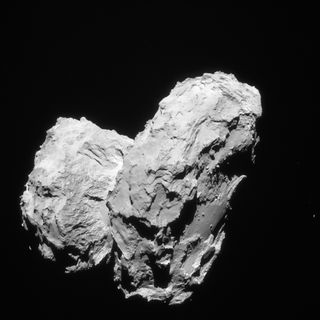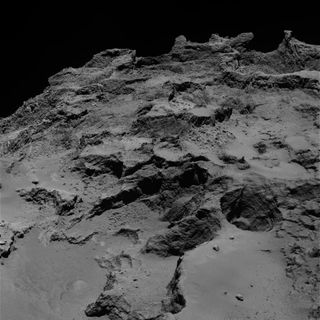2 Comets Collided to Form Rosetta's 'Rubber Ducky' Target

The mystery of the "rubber duck" comet has been solved.
The strange shape of Comet 67P/Churyumov-Gerasimenko, which the European Space Agency's Rosetta spacecraft has been studying for more than a year, arose from the long-ago collision of two separate, slow-moving comets, researchers say.
"How the comet got its curious shape has been a major question since we first saw it," Holger Sierks, of the Max Planck Institute for Solar System Research in Germany, said in a statement. [Spectacular Comet Photos from Rosetta]
"Now, thanks to this detailed study, we can say with certainty that it is a 'contact binary,'" added Sierks, who serves as the principal investigator of Rosetta's Optical, Spectroscopic and Infrared Remote Imaging System (OSIRIS), the main camera system for the mission.
Two separate onions
When Rosetta arrived at Comet 67P in August 2014, scientists noted the icy object's distinctive, two-lobe shape, similar to that of a rubber ducky toy. Two main hypotheses emerged — that a single comet had eroded to form the connecting "neck," or that two comets had merged. The latter theory has been proposed for the formation of other bi-lobed comets.
Matteo Massironi, of the University of Padova in Italy, led a team that identified more than 100 terraces on the surface of the comet, along with parallel layers of material in exposed walls and pits. The scientists then developed a 3D-shape model of the comet to determine the directions of the terraces' slopes and visualize how they extended below the surface.

"It is clear from the images that both lobes have an outer envelope of material organized in distinct layers, and we think these extend for several hundred meters below the surface," Massironi said in the same statement. "You can imagine the layering a bit like an onion, except in this case we are considering two separate onions of differing size that have grown independently before fusing together." It soon became clear that the features were coherently oriented around the comet's lobes, extending to a depth of around 2,100 feet (650 meters).
Get the Space.com Newsletter
Breaking space news, the latest updates on rocket launches, skywatching events and more!
"This was the first clue that the two lobes are independent, reinforced by the observation that the layers are inclined in opposite directions close to the comet's neck," Massironi said.
The scientists then studied the relationship between the local gravityand the orientations of the various features. (In general, layers of material should form at right angles to the gravity of an object.) The team computed the strength and direction of the gravity at the location of each layer.
In one case, they modeled the comet as a single body with a center, while in another they worked with two separate merging comets. They found that the orientation of the layers and the direction of the local gravity were closer to forming right angles in the model with two comets rather than a single one.
"This points to the layered envelopes in the comet's head and body forming independently before the two objects merged later," Massironi said. "It must have been a low-speed collision in order to preserve such ordered strata to the depths our data imply."
The structural similaritiesthroughout the comet suggest that the precursor comets formed through similar accretion processes. The layering observed on other comets during previous missions suggest that they, too, went through a similar formation history, the researchers said.
Erosion still important
Although erosion didn't create the narrow neck of Comet 67P, the team pointed out that it plays a role in how the comet continues to evolve. Local variations in the surface most likely formed as a result of ice turning directly into gas, a process called sublimation. The frozen gases embedded in the layers of the comet are not necessarily distributed evenly through its body.
"This result adds to our growing knowledge of the comet — how it formed and its evolution," Rosetta project scientist Matt Taylor said in the same statement. "Rosetta will continue to observe the comet for another year, to get the maximum amount of information on this celestial body and its place in the history of our solar system."
Massironi presented the results at the 2015 European Planetary Science Congress, which was held from Sept. 27 through Oct. 2 in Nantes, France. The study was also published online late last month in the journal Nature.
Follow Nola Taylor Redd on Twitter @NolaTRedd. Follow us @Spacedotcom, Facebook or Google+. Originally published on Space.com.
Join our Space Forums to keep talking space on the latest missions, night sky and more! And if you have a news tip, correction or comment, let us know at: community@space.com.

Nola Taylor Tillman is a contributing writer for Space.com. She loves all things space and astronomy-related, and enjoys the opportunity to learn more. She has a Bachelor’s degree in English and Astrophysics from Agnes Scott college and served as an intern at Sky & Telescope magazine. In her free time, she homeschools her four children. Follow her on Twitter at @NolaTRedd
Most Popular


